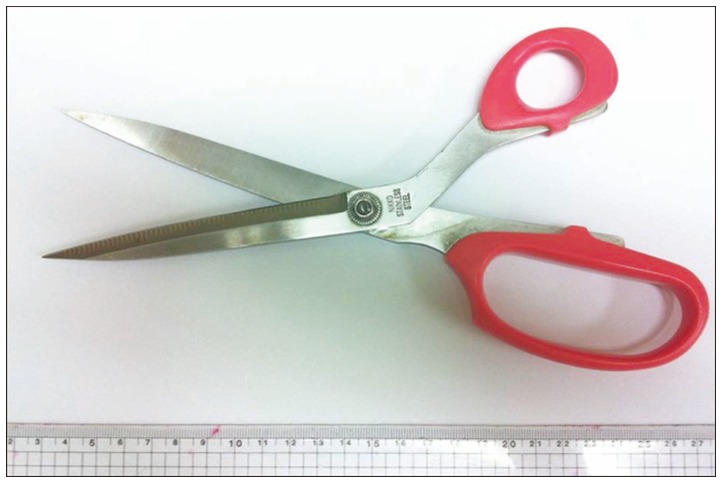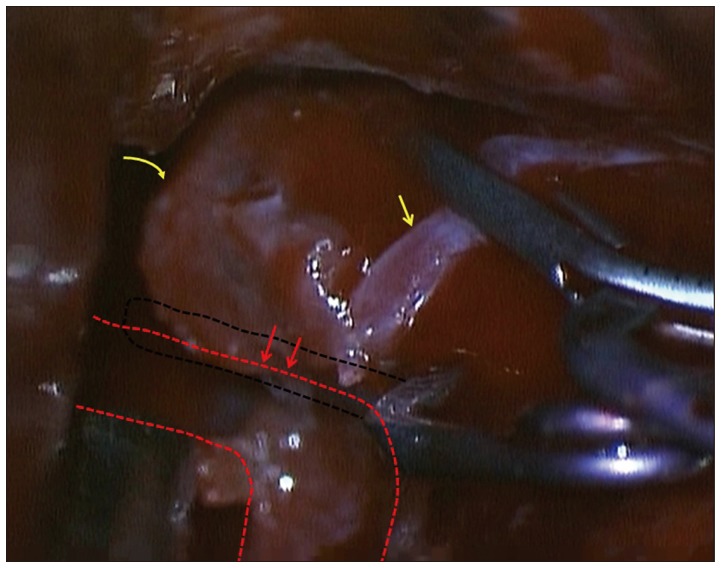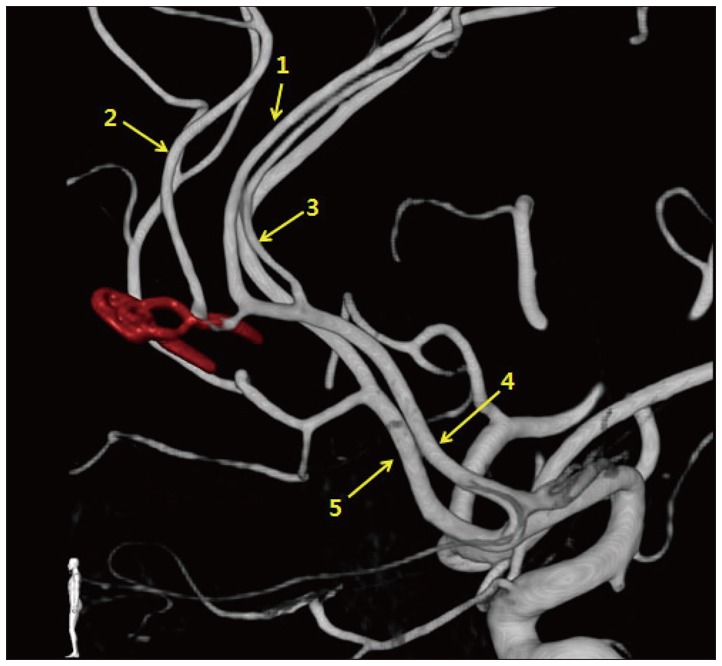J Korean Neurosurg Soc.
2014 Apr;55(4):222-225. 10.3340/jkns.2014.55.4.222.
Traumatic Aneurysm of the Callosomarginal Artery-Cortical Artery Junction from Penetrating Injury by Scissors
- Affiliations
-
- 1Department of Neurosurgery, Seoul Paik Hospital, Inje University College of Medicine, Seoul, Korea. hanibalkms@hanmail.net
- KMID: 2191098
- DOI: http://doi.org/10.3340/jkns.2014.55.4.222
Abstract
- Traumatic intracranial aneurysms (TICAs) are rare and are associated with high rates of morbidity and mortality. TICAs usually result from head injuries caused by traffic accidents, industrial accidents, or gunshots. We report a traumatic aneurysm of the callosomarginal artery-cortical artery junction arising from a penetrating injury by scissors. A 51-year-old woman was admitted to our hospital after suffering a penetrating injury caused by scissors. Computed tomography (CT) and CT-angiography demonstrated a right orbital roof fracture, subarachnoid hemorrhage, frontal lobe hemorrhage, intraventricular hemorrhage, and a traumatic aneurysm of the right callosomarginal artery-cortical artery junction. We trapped the traumatic aneurysm and repositioned a galeal flap. Postoperative CT showed a small infarction in the left frontal lobe. Follow-up angiography two months later showed no residual aneurysm. We suggest that an aggressive surgical intervention be performed whenever TICA is diagnosed.
MeSH Terms
Figure
Reference
-
1. Agrillo A, Sassano P, Mustazza MC, Filiaci F. Complex-type penetrating injuries of craniomaxillofacial region. J Craniofac Surg. 2006; 17:442–446. PMID: 16770179.
Article2. Asari S, Nakamura S, Yamada O, Beck H, Sugatani H. Traumatic aneurysm of peripheral cerebral arteries. Report of two cases. J Neurosurg. 1977; 46:795–803. PMID: 859016.3. Benoit BG, Wortzman G. Traumatic cerebral aneurysms. Clinical features and natural history. J Neurol Neurosurg Psychiatry. 1973; 36:127–138. PMID: 4691685.
Article4. Bilotta F, Rosa G, Delfini R, Pinto R, Fiorani B. Unrecognized periorbital penetrating nail in the brain : case report. Am J Emerg Med. 2007; 25:198–199. PMID: 17276812.5. Burton C, Velasco F, Dorman J. Traumatic aneurysm of a peripheral cerebral artery. Review and case report. J Neurosurg. 1968; 28:468–474. PMID: 5659574.6. Chibbaro S, Tacconi L. Orbito-cranial injuries caused by penetrating non-missile foreign bodies. Experience with eighteen patients. Acta Neurochir (Wien). 2006; 148:937–941. discussion 941-942. PMID: 16763734.
Article7. Di Roio C, Jourdan C, Mottolese C, Convert J, Artru F. Craniocerebral injury resulting from transorbital stick penetration in children. Childs Nerv Syst. 2000; 16:503–506. discussion 507. PMID: 11007502.
Article8. Dooling JA, Bell WE, Whitehurst WR Jr. Penetrating skull wound from a pair of scissors. Case report. J Neurosurg. 1967; 26:636–638. PMID: 6027450.9. Endo S, Sato S, Uneoka K, Takaku A, Suzuki J. [Traumatic aneurysm of the callosomarginal artery : case report (author's transl)]. No Shinkei Geka. 1974; 2:329–336. PMID: 4473746.10. Erkutlu I, Alptekin M, Dokur M, Geyik M, Gök A. Unusual penetration of a construction nail through the orbit to the cranium : a case report. Ulus Travma Acil Cerrahi Derg. 2011; 17:79–82. PMID: 21341140.
Article11. Hansen JE, Gudeman SK, Holgate RC, Saunders RA. Penetrating intracranial wood wounds : clinical limitations of computerized tomography. J Neurosurg. 1988; 68:752–756. PMID: 3357035.
Article12. Jakobsson KE, Carlsson C, Elfverson J, von Essen C. Traumatic aneurysms of cerebral arteries. A study of five cases. Acta Neurochir (Wien). 1984; 71:91–98. PMID: 6731059.
Article13. Kahler RJ, Tomlinson FH, Eisen DP, Masel JP. Orbitocranial penetration by a fern : case report. Neurosurgery. 1998; 42:1370–1373. PMID: 9632198.14. Kassell NF, Torner JC, Haley EC Jr, Jane JA, Adams HP, Kongable GL. The International Cooperative Study on the Timing of Aneurysm Surgery. Part 1 : Overall management results. J Neurosurg. 1990; 73:18–36. PMID: 2191090.15. Kumar A, Pandey R, Singh K, Sharma V. Scissors in brain : an unusual presentation of tribal culture in India. Turk Neurosurg. 2011; 21:413–417. PMID: 21845581.16. Lempert TE, Halbach VV, Higashida RT, Dowd CF, Urwin RW, Balousek PA, et al. Endovascular treatment of pseudoaneurysms with electrolytically detachable coils. AJNR Am J Neuroradiol. 1998; 19:907–911. PMID: 9613510.17. Matsumoto S, Hasuo K, Mizushima A, Mihara F, Fukui M, Shirouzu T, et al. Intracranial penetrating injuries via the optic canal. AJNR Am J Neuroradiol. 1998; 19:1163–1165. PMID: 9672032.18. Miller CF, Brodkey JS, Colombi BJ. The danger of intracranial wood. Surg Neurol. 1977; 7:95–103. PMID: 835079.19. Mizutani T, Aruga T, Kirino T, Miki Y, Saito I, Tsuchida T. Recurrent subarachnoid hemorrhage from untreated ruptured vertebrobasilar dissecting aneurysms. Neurosurgery. 1995; 36:905–911. discussion 912-913. PMID: 7791980.
Article20. Nakstad P, Nornes H, Hauge HN. Traumatic aneurysms of the pericallosal arteries. Neuroradiology. 1986; 28:335–338. PMID: 3762911.
Article21. Schneider RC. Head injuries in infancy and childhood. Surg Clin North Am. 1961; 41:1255–1269. PMID: 13908953.
Article22. Schreckinger M, Orringer D, Thompson BG, La Marca F, Sagher O. Transorbital penetrating injury : case series, review of the literature, and proposed management algorithm. J Neurosurg. 2011; 114:53–61. PMID: 20868210.
Article23. Yang TC, Lo YL, Huang YC, Yang ST. Traumatic anterior cerebral artery aneurysm following blunt craniofacial trauma. Eur Neurol. 2007; 58:239–245. PMID: 17851246.
Article24. Yokota H, Tazaki H, Murayama K, Shimura T, Higuchi H, Yajima K, et al. [Traumatic cerebral aneurysm : 94 cases from the literature and 5 cases observed by the authors]. No Shinkei Geka. 1983; 11:521–528. PMID: 6877511.








